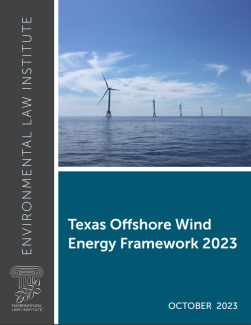It was former Pennsylvania Senator Franklin Kury who famously stated, “Freedom of speech will be meaningless if we suffocate on polluted air.” This statement may at first seem to be glib sarcasm, but given that air pollution is causing many to choke from asthma attacks or die from heart attacks, it is a statement that rings true. A similar reflection and associated anecdote can be made with regards to water pollution, ecosystem desecration, species loss, and, of course, the climate.
For many working to advance environmental protection—whether by grassroots activism, education, or through legal practice—there is a growing perspective that, absent strong oversight or motivation, too many in government or business are unwilling to set aside political, personal, or financial agendas necessary to conserve the natural resources essential for human health, survival, and good-quality lives—much less the health and safety of future generations yet to be born. Accordingly, as resources have rapidly been depleted and degraded throughout the last two centuries, and as the reality of the climate crisis comes into focus, efforts to recognize environmental rights publicly and legally are gaining momentum across the globe.
Last July, the UN General Assembly declared that a clean, healthy, and sustainable environment is a recognized human right; a right so important that it is entitled to high-level government action. In accord with this call to arms, while providing varying degrees of protection—and often unfortunately failing to give environmental rights the same legal standing as other recognized rights—more than one hundred nations, according to the UN, now recognize environmental rights somewhere in their constitutions.
Notably, the United States is not among them. For the most part, in this country, environmental matters are relegated to a legal system focused primarily on data gathering and analysis and subsequent permitting of pollution and degradation. There is rarely a mandate to consider and act upon the compounding effects of cumulative pollution inputs, or to avoid disproportionately and repeatedly foisting harmful environmental consequences on communities of color, Indigenous communities, or low-income communities. It is a system that also allows for gaps and loopholes that advance dangerous industrial operations and the use of toxic substances even absent a rigorous analysis of safety or environmental impacts.
When government actions in the United States affecting the environment are challenged in court, judges are tasked with enforcing statutory language often drafted as a political compromise and where environmental consequences, even environmental racism, have been forthrightly legalized. Ultimately, in this system, courts are frequently compelled to defer to an agency’s determination, even when environmental impacts of challenged government actions are demonstrably harmful or inequitable. In the final analysis, there is no consistent check on government action when this system of laws fails to address a crisis of water pollution, air pollution, toxic contamination, or climate change; has exacerbated environmental racism; or has allowed for the devastation of ecosystems and species.
But there are states pursuing a different path. A growing number are joining the national Green Amendments for the Generations movement. In so doing, these states are leading the way in environmental rights recognition and demonstrating the moral, legal, environmental justice, and generational value of raising up environmental rights so they are given the same constitutional standing as our highest-priority freedoms like speech, religion, and civil rights.
Importantly, a state constitutional environmental rights amendment is not necessarily synonymous with a Green Amendment. Admittedly, while the majority of state constitutions recognize the value of environmental protection within their texts to varying degrees, they are also demonstrating that simple “recognition” does not equate with meaningful protection or the same highest legal regard given to other fundamental rights. The distinction is that this is a level of protection the Green Amendment approach, by definition, does provide. For example, New Mexico’s constitution loftily proclaims that “protection of the state’s beautiful and healthful environment is hereby declared to be of fundamental importance to the public interest, health, safety, and the general welfare.” This language, however, fails to create enforceable individual environmental rights on par with other constitutional rights. Like most states, New Mexico’s constitution merely reaffirms that environmental concerns are to be addressed legislatively and are subject to the same political whims that have heretofore failed to protect communities from major environmental threats.
Upon analysis, while 44 states address the environment in their constitutions in one form or another, only three—Pennsylvania, Montana, and New York—raise up the inalienable, inherent, and indefeasible rights to clean water and air and healthy environments. In the three states, these rights are given highest constitutional, fundamental rights standing like that afforded to property rights and the right to free speech and the free exercise of religion.
In fact, most state environmental rights provisions tend to suffer the same fundamental flaws: they declare environmental rights to be good public policy as opposed to being enforceable rights. They relegate the vindication of environmental rights to the legislative process, where they currently stand, with all of the failings of majority rule. They focus on rights to activities such as fishing, hunting, trapping, or navigation while ignoring life-supporting fundamentals such as water, air, climate, or healthy ecosystems. They fail to raise up environmental rights so they are on par with, as opposed to being subservient to, other fundamental rights like those protecting property and people’s economic expectations. And they fail to ensure environmental rights are inviolate from infringement absent a compelling state interest.
To give the highest constitutional fundamental rights standing, key Green Amendment criteria must be met. Here we turn to the 2017 book The Green Amendment: Securing Our Right to a Healthy Environment. It describes a constitutional provision that meets these essential criteria. A Green Amendment is a self-executing declaration of environmental rights included in a constitution’s bill of rights that equitably recognizes and protects the rights of all people, including future generations, to environmental essentials. Ideally, Green Amendments also create a constitutional obligation for the government to serve as trustee, protecting a state’s natural resources, with present and future residents as the identified beneficiaries.
Including these key elements ensures environmental rights are given the same conservative protection and respect offered to other inalienable rights. For example, as with other bill of rights protections in state constitutions, Green Amendments are a limitation on government authority, protecting environmental rights from government infringement or overreach—as opposed to being a new grant of authority. Like all other states, Pennsylvania’s constitution has a section devoted to specific rights held by the people. As discussed by Chief Justice Ronald Castille in the plurality opinion of the landmark case Robinson Township, Delaware Riverkeeper Network v. Commonwealth, “The Declaration of Rights assumes that the rights of the people . . . are inherent in man’s nature and preserved rather than created by the Pennsylvania Constitution.” The court also ruled that “the Declaration of Rights is that general part of the Pennsylvania Constitution which limits the power of state government.’’ This heightened constitutional standing also reorients government decisionmaking so that environmental impacts, and efforts to avoid them, are an up-front part of the process of government—requiring consideration of cumulative impacts and prevention of harm from the outset of government decisionmaking when it is best able to be avoided or addressed.
The self-executing nature of a Green Amendment ensures that the language defines and guides the interpretation and application of state environmental protection laws and regulations, as opposed to the constitutional right being defined through legislation. A self-executing amendment also allows the constitutional right to be relied upon when there is a regulatory or statutory gap in environmental protection or when implementation of the law is causing disproportionate environmental justice impacts that are technically legal and otherwise cannot be addressed. Green Amendments create a duty of all government entities to respect and protect enumerated environmental rights; the constitutional duty is not limited to the legislature.
Environmental racism is a devastating outgrowth of our system of laws, because the facially neutral U.S. legal system fails to mandate equitable environmental protection and justice for all communities. In contrast, Green Amendments equitably protect the rights of all people regardless of race, ethnicity, tribal membership status, socioeconomics, gender, or geography. As a result, government action that demonstrably causes or contributes to disproportionate environmental impacts on communities of color, Indigenous communities, or low-income communities becomes constitutionally suspect, with the opportunity for an equitable remedy.
The importance of Green Amendment protections for environmental rights and natural resources at both the state and federal level—the ultimate goal of the Green Amendments for the Generations movement—was starkly demonstrated this past year. In a series of cases in its last session, the U.S. Supreme Court made clear that our inalienable, fundamental rights are best protected from governmental infringement—including judicial undermining—when constitutional language recognizing those rights is explicit.
In Dobbs v. Jackson Women’s Health Organization, because the U.S. Constitution “makes no express reference to the right to obtain an abortion,” the Court felt free to overturn 49 years of constitutional recognition and protection. A majority of the justices joined forces to apply a historical analysis and conclude that the right to an abortion is not an essential component of ordered liberty, and thus not protected by the 14th Amendment’s Due Process Clause. By strictly looking to the past—at a time when women were seen as property and medical procedures were rudimentary—the Court eviscerated a right to reproductive health care relied on by Americans, all of whom may be impacted regardless of gender identity. The lack of explicit constitutional language recognizing abortion rights and the right to bodily autonomy left the path clear for this radical judicial activism.
In keeping with the focus on explicit constitutional recognition of rights, the Court relied upon its interpretation of the plain language of the Second Amendment to strike down New York state’s restrictions on carrying concealed firearms in New York State Rifle & Pistol Association, Inc. v. Bruen. In doing so, the Court held that the “plain text” of the amendment protected the carrying of handguns publicly for self-defense. The Court then required the state to prove, through historical analysis, that its regulation of this protected activity was consistent with traditional firearm regulation at the time the Second Amendment was adopted. As demonstrated in this case, the explicit inclusion of gun rights for constitutional protection shifts the burden from a public seeking to protect the entitlement to the government entity seeking to infringe upon it. In short, when a right is clearly spelled out in constitutional language, the government is put on the defensive and must justify any action that infringes upon it.
The third dramatic case of the session solidified the value of constitutional rights recognition in the environmental context. In West Virginia v. Environmental Protection Agency, the Court invalidated an EPA regulation designed to aggressively combat climate change by shifting electricity generation nationwide from coal to natural gas and to renewable energy sources. In large part because of the claimed economic disruption this rule would cause to the power-generating sector, the Court concluded that EPA needed clear instruction from Congress that this sort of disruption was intended in the agency’s efforts to address air pollution under the Clean Air Act. Absent explicit constitutional entitlement, the rights of the people and future generations to healthy environments free from health-harming air pollution and climate disruption were ignored and diminished by the economic concerns of a single industry. Absent explicit legislative or constitutional instruction, the court felt free to reject 40 years of precedent requiring deference to the expertise and authority of a regulatory agency entrusted by Congress with protecting air quality, and instead supplanted the agency’s regulatory authority, oversight, and scientific expertise with the Court’s own policy determination of what was a rational outcome.
The thread through each of these cases is the existence or absence of an explicit pronouncement of a fundamental right that is self-executing, inalienable, and serves as a limitation upon, rather than being defined by, governmental legislation, regulation, policies, programs, and budgets. The Dobbs decision illustrates the risk of asking a court to infer specific rights through interpretation of broader constitutional language—one court’s conclusion may be more easily undermined by another court’s using different reasoning. Bruen emphasizes the strength of a clear and plain declaration of rights, and the steep mountain that the government must climb to overcome the presumption that infringing action is unconstitutional. Sadly, West Virginia once again elevates the familiar hand-wringing of polluting corporations claiming regulatory takings or economic collapse above the viability of future generations, simply because the right to a life-sustaining planet is not recognized in the U.S. Constitution. Together, these cases demonstrate that under our current legal regime, the lack of explicit constitutional recognition leaves our environment at the mercy of politics and the courts.
Having already learned the value of explicit constitutional recognition, three states have constitutional provisions that meet the defining criteria of a Green Amendment and in so doing give environmental rights and natural resource protection the highest constitutional standing—one that cannot be disregarded by politicians or judges. In Pennsylvania and Montana, where the rights of the people to clean and healthy environments have explicitly benefitted from Green Amendment protection for several years, communities have been able to successfully challenge legislation, regulations, permitting, and other government actions that—either procedurally or substantively—failed to give due recognition or protection to the explicitly recognized environmental rights of the people or failed to fulfill a clearly stated obligation of government to protect natural resources for both present and future generations. New York state secured passage of a constitutional Green Amendment in 2021; we will soon see what that state’s heightened constitutional recognition provides.
Although this article discusses Supreme Court case law interpreting the federal constitution, the Green Amendment movement sweeping the nation is carefully crafted by the Green Amendments for the Generations organization to focus on states first. Cooperative federalism is a mainstay of U.S. environmental protection law, ensuring that states maintain a high level of obligation and responsibility for environmental protection, and the right to put in place more protective standards when they desire. In the realm of environmental statutes and regulation, federal law provides a floor of minimum acceptable protections, while states are free to regulate pollution more stringently. In addition, many governmental tools for environmental protection, such as land use authority, are solely within the authority of states. Accordingly, federal preemption of state action taken in compliance with a Green Amendment would occur only on the rarest of occasions.
In addition, constitutional amendments at the state level are undertaken with regularity in response to public demand—as demonstrated by the passage of constitutionally protected abortion rights in three states during the recent election. By focusing on state constitutions first, the Green Amendment movement is securing constitutional standing and stronger environmental protections in the near term at the state level, while at the same time cultivating the public understanding and political support necessary for the three-fourths-of-the-states consensus required for the passage of a federal Green Amendment.
Each state has its own prescribed amendment strategy—generally including a pathway where the amendment is proposed to and must be passed by the state legislature one or two times by varying percentages, ranging from majority vote to three fifths, thereafter bypassing the governor’s office and going straight to the people for approval. Some states include a ballot initiative and still others include a constitutional convention as an option (but generally the convention approach is rejected for fear that reopening the constitution to consider environmental rights opens the door to revisiting the entire document).
A state-by-state approach is also in keeping with the concept that the states are laboratories of democracy, and progressive movements can gain momentum without outsized industry-funded political backlash based on speculation and fear-mongering. The value of this approach can be seen in a different context, that of marijuana legalization. Criminalization of marijuana began in the early 20th century, fueled by fear of immigrant populations and set ablaze by hysteria over the scientifically dubious notion of “reefer madness.” Beginning with California in 1996, however, states began legalizing marijuana for medical purposes—now, only 11 prohibit the use of medical marijuana. Before 2012, no state allowed the sale of marijuana for recreational use. As of this writing, 19 states and the District of Columbia have legalized recreational marijuana, with two additional states having voted in favor of legalization in the 2022 midterm elections.
This state-led momentum has provided the political and empirical support needed to reform federal marijuana laws. In April 2022, the House of Representatives passed the Marijuana Opportunity Reinvestment and Expungement Act, which would remove marijuana from the scheduled substances under the Controlled Substances Act. In October, President Biden pardoned all federal offenses for simple possession and called for governors to do the same. Biden directed the attorney general and the secretary of health and human services to review whether marijuana should remain a Schedule I substance under the Controlled Substances Act. Without multiple successful instances of marijuana law reform in the states, it is unlikely that federal reform would succeed, and it would have been susceptible to the same fear-mongering that led to marijuana criminalization in the first place.
The Green Amendments movement is using a similar approach for introducing the concept of constitutional environmental rights to the public. The commonsense concept that we the people have a birthright to the life-sustaining properties of our planet without undue interference by government is held as a truth by many in the United States. Seeing those rights explicitly recognized by state and local government will have a real and tangible impact on quality of life and will empower the beneficiaries of a Green Amendment to speak to their experience, thereby dispelling bad-faith arguments that would otherwise pose a real threat to ultimate federal adoption of a Green Amendment.
In a time when the human health, quality of life, safety, economic harms, and systemic racial impacts of environmental desecration are well understood, people are looking for options to ensure they are meaningfully heard, and their environmental protection needs are properly prioritized in all government action. They are looking for solutions that are more than just elevating different people to legislative office at the next election. Constitutional environmental rights recognition that meets the Green Amendment definition provides a transformational shift in law, protection, and power—ensuring that when government fails to fulfill its fundamental duty to protect the inalienable human rights of all people to clean water and air, healthy soils, and environments, thriving wildlife and ecosystems, and a stable climate, people have an ultimate, meaningful, and timely say in the final outcome. It is a solution whose time has come, and one that impacts all areas of environmental need in one meaningful declaration. It is a solution that transcends political party affiliation, generation, race, ethnicity, and socioeconomic status—as we are demonstrating in states pursuing this constitutional path.
We have learned from the current Supreme Court that when it comes to environmental rights, language and its constitutional placement must leave no room for doubt that these are self-executing, enforceable rights that belong to the people and are not confined to the limited protections legislators may choose to provide. Clear constitutional language gives the environmental rights movement a better guarantee of permanence in the legal system, the presumption that any government action that infringes upon environmental rights is invalid, and a recognition that environmental rights are at least as important as property rights and certainly more important than economic expectations. That is what a Green Amendment provides. TEF







